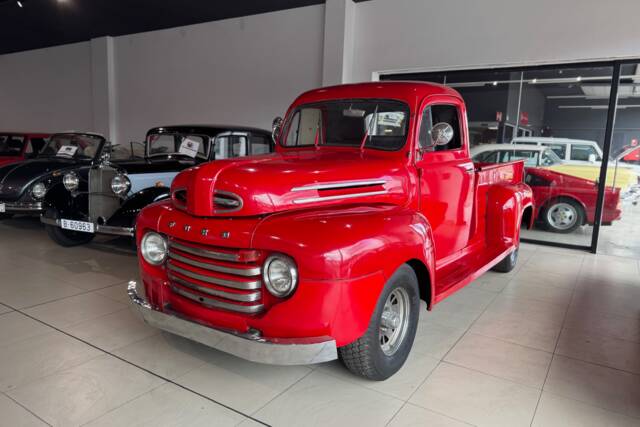Ford F 1 classic cars for sale
The Ford F 1 stands as the original first-generation Ford F-Series pickup, produced from 1948. With its robust design, distinctive American pickup look, and range of inline-six and V8 engines, it became an instant workhorse and style icon for post-war America. This model laid the foundation for the world's most successful pickup series, retaining unmatched authenticity and mechanical simplicity that is sought after by classic vehicle fans today.
Search results

Ford F 1 listing references from Classic Trader
Below you will find listings related to your search that are no longer available on Classic Trader. Use this information to gain insight into availability, value trends, and current pricing for a "Ford F 1" to make a more informed purchasing decision.

1950 | Ford F-1 "Woody"
Frame-off Restoration - Upgraded T5 Manual Gearbox
History of the Ford F 1
Launched in 1948, the Ford F 1 marked Ford’s first post-war compact pickup in the new F-Series, a lineup intended to cover various payload classes from F-1 up to F-8. The Ford F 1 (and its Canadian Mercury twin) brought fresh design after decades of prewar technology, introducing a proper ladder chassis, improved convenience for daily drivers, and a range of body styles. By the early 1950s, the F 1’s utility and its distinctive, practical appearance gained it favor among American farmers and tradesmen. The F 1 was succeeded by the F-100 in 1953, but the influence of these first pickups is seen in Ford’s ongoing dominance in the US pickup truck segment.
Model History
The Ford F 1 made up the starting point of the F-Series lineage, built from 1948 to 1952. Built in multiple body styles and payload versions up to F-8, its name reflected the maximum GVW. From 1953, the model name shifted to F-100 as part of the second-generation overhaul, though the basic philosophy stayed constant: solid ladder-frame, robust leaf spring suspension and a choice of durable inline-six or flathead V8 petrol engines. Distinctive square styling and details like integrated headlights in later versions marked ongoing evolution. Eventually, continual development saw the F-Series become more refined, leading to later generations with crew cab options and increased comfort.
Highlights of the Ford F 1
The Ford F 1 is recognised for its unmistakable 1950s American pickup appearance; features include a long steel bed, wooden cargo floor (with optional chrome rails), robust ladder-frame chassis, and classic flathead V8 or inline-six engines. Optional two-tone paint schemes, chromed bumpers and trim, and practical features like external spare wheel carrier reflect the era’s design. Easily restorable, the F 1 supports both period-correct and modernised rebuilds (e.g., with contemporary 5-speed Tremec transmissions).
Technical Data
Special Editions and Collectible Models
The Canadian-market Mercury-badged variants are of particular note for collectors, standing out due to different trim and branding. Factory two-tone paint, dealer-fitted accessories such as removable hay rails or upgraded interior trim, and original long-bed (Long-Bed) versions with timber composite freight platforms can also be considered rare or unique within the model range.
Engine and Performance, Transmission and Handling
Ford F 1 models are frequently powered by the period-correct 255 cu in Flathead V8, notable for its low-end torque, and were typically paired with a three-speed crashbox manual transmission. Slow, deliberate gear synchronisation is necessary, though conversions to modern 5-speed manual boxes are common for improved usability. The F 1 uses a solid axle, leaf spring suspension setup both front and rear, making for a firm, rugged ride more suited to unpaved roads and loads than to comfort or agile cornering. Braking is by drum brakes, either mechanical or hydraulic depending on year. Driving one offers direct steering, mechanical feedback, and the unmistakable feel of an all-metal 1950s truck. Most well-known configurations are single-cab, long-bed variants in rear-wheel drive with flathead V8. Collector attention often focuses on well-preserved original examples or those restored with period-correct details.
Interior, Comfort, Exterior and Design
The Ford F 1’s design is emblematic of 1950s American utilitarianism: a sturdy steel body built on a ladder frame, signature chrome bumpers, and large round headlights. The interior is basic: a bench seat, manual window winders, and simple steel dashboard. Details like original two-tone paint, chrome embellishments, wood-lined beds with optional removable hay rails, and steel wheels with chrome hubcaps express subtle luxury amid functional engineering. Optional upgrades from period included improved soundproofing, padded dashes, and accessory equipment for the cargo bed. Exterior spare wheel mounting, a hallmark of the era, remains authentic.
Summary
The Ford F 1 stands as a milestone at the birth of the modern pickup – both mechanically straightforward and instantly recognisable for its shape, sound, and purpose. Today, the F 1 continues to appeal to those interested in original American craftsmanship, offering a hands-on mechanical driving experience and broad potential for custom restoration or accurate period reconstruction.
